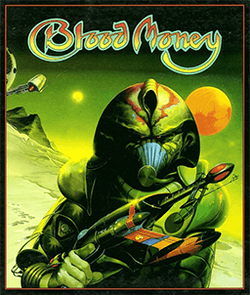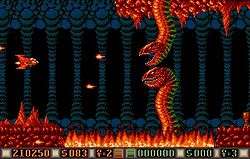Blood Money (video game)
| Blood Money | |
|---|---|
 Cover art, designed by Peter Andrew Jones | |
| Developer(s) | DMA Design |
| Publisher(s) | Psygnosis |
| Designer(s) | Tony Smith |
| Programmer(s) | David Jones |
| Composer(s) |
Ray Norrish Fredrik Segergalk |
| Platform(s) | Amiga, Atari ST, Commodore 64, MS-DOS |
| Release |
Amiga, Atari ST May 1989 MS-DOS 1989 Commodore 64 1990 |
| Genre(s) | Scrolling shooter |
| Mode(s) | Single player, multiplayer |
Blood Money is a side-scrolling shooter video game developed by DMA Design. It was published by Psygnosis in 1989 for the Amiga, Atari ST and MS-DOS, and in 1990 for the Commodore 64. The game is set in four different locations on a planet, where players are tasked with attacking the enemies and defeating the bosses.
The game began development immediately after Menace, and borrowed similar gameplay elements. The development team used advanced hardware to develop Blood Money, utilising improved graphical and technological processes. The game was inspired by the presentation of Mr. Heli, and the animations of Blood Money would later inspire the development of Lemmings. The game was released to positive reviews; praise was given to the game's graphics and gameplay. The game was also commercially successful, selling over 40,000 copies.
Gameplay

Blood Money is a horizontal side-scrolling shooter that uses 2D computer graphics. Players move through four stages on the planet, taking control of a different vehicle in each level: a helicopter in the metal world, a submarine in a water world, a spacesuit in an ice world, and a fighter jet in a fire world. Each vehicle features unique weaponry, which players use to attack all advancing enemies. Players can upgrade their vehicle with power-ups, which grant them additional weapons and upgrades, such as support missiles and neutron bombs.[1] The vehicles' energy acts as players' health, and is depleted when the vehicle makes contact with enemies and walls. When all energy is lost, players lose a life; three lives are provided at the beginning of the game, and additional lives can be collected as players progress through the levels. When all three lives are lost, the game ends and players are sent to the title screen.[2] The first two levels may be selected from the beginning of the game; after one level is complete, players can select any remaining world without restrictions. At the end of each level, players must defeat a boss.[1]
Development
Following the successful release of Menace in 1988, David Jones began developing Blood Money on 4 January 1989, on the 25MHz 386-DX computer that publisher Psygnosis granted him, alongside a Personal Development System.[3] Jones saw Blood Money as a "further development" of the concept used in Menace.[4] Jones was heavily inspired by the "cuteness" of Mr. Heli (1987) during the development of Blood Money.[3] The game's cover art was designed by British artist Peter Andrew Jones for the novel Protector (1973) by Larry Niven, and was adapted for the game's cover.[5]
With Blood Money, Jones was determined to utilise the full colour range of the Amiga, opting to use the blitter as opposed to the hardware scrolling; the blitter allowed graphics to be drawn quickly. Tony Smith, who had worked on Menace, produced the graphics for Blood Money, while Jones began work on a new scrolling system. While developing his own game, Talisman, Mike Dailly created a compact method to move enemies on-screen, which Jones incorporated into Blood Money.[3] The game's animations fascinated Jones' friend Gary Timmons, who then began experimenting with Deluxe Paint; his work on the program led to his employment at DMA Design, and inspired some of the animations used in DMA's next game, Walker (1993).[6] The game's introduction required a star field, which Jones took from a quick demonstration that Dailly had been working on.[7]
The game was ported to the PC by Tim Ansell of Creative Assembly,[8] and to Atari ST by Jones' friend Wayne Smithson,[9] while Dailly began porting the game to the Commodore 64 following the Personal Computer World Show in September 1989.[6] Dailly used the code from the Talisman demo, and wrote a new sprite system. He also re-worked the multi-directional scrolling,[10] and wrote his own tape loading routines, wanting one that allowed players to play a simple game while Blood Money loaded.[11] Smith designed the graphics for the port, and became confused by the limitations of the hardware: he had to draw double pixels in Deluxe Paint, and was limited to sixteen colours.[10] Dailly finished developing the Commodore 64 version of Blood Money on 12 March 1990.[9]
Reception
| Reception | ||||||||||||||||||||
|---|---|---|---|---|---|---|---|---|---|---|---|---|---|---|---|---|---|---|---|---|
| ||||||||||||||||||||
Blood Money received mostly positive reviews from critics upon release, particularly for its gameplay, graphical design, and sound. Gary Barrett of ST/Amiga Format wrote that the game is the best shoot 'em up game on the Amiga.[18] Zzap!64 listed Blood Money as the best Amiga game of the 1980s,[20] and ST Format named it the second-best shoot 'em up game of 1990.[21] The game sold 40,000 copies, which is double the sales of Menace.[22]
Stuart Wynne of Zzap!64 found the game "superb to play", while Robin Hogg of the same publication wrote that it "measures up" to the game's "brilliant" graphics.[19] The One found the game to be among the "most challenging and technically accomplished" shoot 'em ups,[16] while ACE called it "compelling".[13] Conversely, Mike Pattenden of CU Amiga criticised the difficulty, noting its lack of rewards.[14]
Critics praised the game's graphical qualities. Paul Glancey of Computer and Video Games lauded the game's opening sequence, and called the sprites among "the best designed and most fluidly animated" in an Amiga game.[1] The Games Machine found the graphics "utterly impressive",[15] and Barrett of ST/Amiga Format wrote that the game is "in a class of its own", praising the sprite animations.[18] Zzap!64's Hogg commended the animation and backgrounds.[19] Conversely, CU Amiga's Pattenden felt that the graphics lack depth.[14]
The game's use of sound received positive reactions. Phil King of Zzap!64 was impressed by the soundtrack, particularly praising the introductory music.[19] The Games Machine echoed similar remarks, writing that the game features "excellent" sound,[15] and Glancey of Computer and Video Games wrote that the sound chip was "put ... to bloomin' good use".[1] Barrett of ST/Amiga Format preferred the sound effects over the music, though felt that they were inferior to those in Menace.[18] Pattenden of CU Amiga felt that the sound is "a poor tune and some average effects",[14] while ACE called it "a little weedy".[13]
References
- 1 2 3 4 5 6 Glancey, Paul (June 1989). Taylor, Graham, ed. "Blood Money". Computer and Video Games. Future plc (92): 48. Retrieved 5 October 2015.
- ↑ "Blood Money : DMA Design Limited : Free Streaming". Archive.org. Internet Archive. 27 December 2014. Archived from the original on 5 July 2015. Retrieved 5 October 2015.
- 1 2 3 Dailly, Mike (2004). "The History of DMA – Chapter 2, part 1". Mike Dailly. Archived from the original on 5 October 2015. Retrieved 5 October 2015.
- ↑ DMA Design, ed. (1989), Blood Money Instruction Booklet, Liverpool: Psygnosis, p. 12, archived from the original on 5 October 2015, retrieved 5 October 2015
- ↑ Jones, Peter Andrew. "Protector". Peter Andrew Jones. Archived from the original on 5 October 2015. Retrieved 5 October 2015.
- 1 2 Dailly, Mike (2004). "The History of DMA – Chapter 2, part 4". Mike Dailly. Archived from the original on 5 October 2015. Retrieved 5 October 2015.
- ↑ Dailly, Mike (2004). "The History of DMA – Chapter 2, part 3". Mike Dailly. Archived from the original on 5 October 2015. Retrieved 5 October 2015.
- ↑ DMA Design, Creative Assembly (1989). Blood Money. DOS. Psygnosis. Scene: Main menu.
IBM Conversion: Tim Ansell
- 1 2 Dailly, Mike (2005). "The History of DMA – Chapter 3, part 2". Mike Dailly. Archived from the original on 5 October 2015. Retrieved 5 October 2015.
- 1 2 Dailly, Mike (2004). "The History of DMA – Chapter 2, part 5". Mike Dailly. Archived from the original on 5 October 2015. Retrieved 5 October 2015.
- ↑ Dailly, Mike (2005). "The History of DMA – Chapter 3, part 1". Mike Dailly. Archived from the original on 5 October 2015. Retrieved 5 October 2015.
- ↑ Rignall, Julian, ed. (August 1990). "Update: Blood Money". Computer and Video Games. Future plc (105): 58. Retrieved 5 October 2015.
- 1 2 3 4 Cooke, Steve, ed. (November 1989). "Blood Money". ACE. EMAP (26): 97. Retrieved 5 October 2015.
- 1 2 3 4 Pattenden, Mike (June 1989). "Blood Money". CU Amiga. EMAP: 54–55. Archived from the original on 15 October 2007. Retrieved 5 October 2015.
- 1 2 3 Kean, Roger, ed. (June 1989). "Blood Money". The Games Machine. Newsfield Publications (19): 43. Retrieved 5 October 2015.
- 1 2 Brennan, Ciarán, ed. (June 1991). "Blood Money". The One. EMAP (33): 93. Retrieved 5 October 2015.
- ↑ Higham, Mark (September 1989). "Blood Money". ST Format. Future plc (2): 72–73. Retrieved 5 October 2015.
- 1 2 3 4 Barrett, Gary (May 1989). "Blood Money". ST/Amiga Format. Future plc (11): 72–73. Archived from the original on 15 October 2007. Retrieved 5 October 2015.
- 1 2 3 4 Wynne, Stuart; Hogg, Robin; King, Phil (July 1989). "Blood Money". Zzap!64. Newsfield Publications (51): 68–69. Archived from the original on 15 October 2007. Retrieved 5 October 2015.
- ↑ Wynne, Start; King, Phil (January 1989). "The Best Games of the 80's Decade". Zzap!64. Newsfield Publications (57): 28–30. Retrieved 5 October 2015.
- ↑ Hutchinson, Andy (January 1991). "The Top 50 Games of 1990" (PDF). ST Format. Future plc (18): 34–37. Retrieved 5 October 2015.
- ↑ Dailly, Mike (2004). "The History of DMA – Chapter 4, part 1". Mike Dailly. Archived from the original on 3 October 2015. Retrieved 3 October 2015.